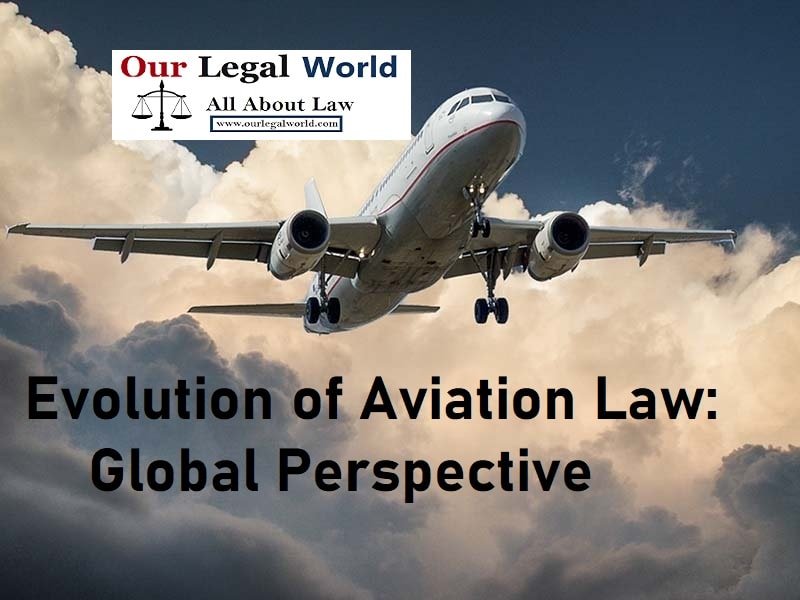Evolution of Aviation Law: Global Perspective
Introduction
In our society, legal regulations shape every aspect of our existence, ensuring harmony and defining the rights and responsibilities of individuals. Laws are indispensable for the advancement of humanity, preventing conflicts and facilitating progress.
What is Aviation Law?
Air law, a subset of international law, oversees civil aviation and encompasses international organizations. However, it does not encompass military aircraft, customs enforcement, or police services. Aviation law deals with air traffic rights, safety and security during air transport, economic rules of airways, as well as operation of airports.
Aviation Law stands as an independent field encompassing a set of regulations and principles that are applicable to both domestic and international aviation. It serves to not only oversee the interactions between nations, passengers, and aviation service providers but also to manage its effects on the broader environment. Additionally, it empowers governmental authorities to establish rules pertaining to aircraft export, import, manufacturing, and aircraft protection.
Also Read: Cable Television and Copyright Protection in India
Need of Aviation Law: Its scope and purposes
The scope of aviation law is very wide. It is a multi-dimensional branch of study. It is dependent on various factors viz.
- The knowledge about the aviation technology,
- Private air law,
- Public air law,
- Law making aspects,
- Safety and security laws,
- Air space management concept,
- Punishment and liability aspects,
- Rules and regulations of air services,
- Air agreements between countries.
The significance of aviation law becomes evident when considering its strong association with the economic progress of nations. Aviation law promotes fairness among different countries, fostering collaboration and assisting in the resolution of conflicting claims between nations. Consequently, aviation law plays a crucial role in addressing the everyday challenges within the aviation industry.
Evolving Aviation Law: Global Perspective
The evolution of aviation law on a global scale has been driven by the rapid growth and globalization of the aviation industry. This evolution has involved the development of international agreements, treaties, and regulations to ensure the safe and orderly conduct of civil aviation across borders.
Prior to 1910, the initial effort to establish international aviation regulations occurred when German balloons conducted several flights over French territory. Due to safety concerns, the French government opted to address this issue through a mutual agreement between the two nations. As a result, in 1910, the Paris Conference convened. Notably, this conference did not advocate for the concept of unrestricted airspace but instead emphasized the sovereignty of states over the airspace above their respective territories.
However, following the conclusion of World War I, on February 8, 1919, the inaugural scheduled air service between Paris and London commenced. During a convention held at that time, discussions revolved around the existing rules and regulations pertaining to aviation. It was necessary to make choices regarding the utilization of open airspace and the regulations reminiscent of maritime law versus the regulations implemented by individual states. Additionally, the field of Air Law was expected to conform to the functional principles applied to other modes of transportation.
Important International Conventions
To regulate aviation and aerial navigation, a number of international conventions have been formulated. They are as follows:
Convention Relating to the Regulation of Aerial Navigation (Paris Convention), 1919
The Convention Relating to the Regulation of Aerial Navigation, commonly known as the Paris Convention of 1919, was an international treaty that aimed to establish the foundational framework for the regulation of civil aviation in the aftermath of World War I.
The Paris Convention affirmed the principle of national sovereignty over the airspace above a country’s territory. It recognized the right of each nation to regulate and control the use of its airspace. It recognized the immunity of military and state aircraft from certain regulations when engaged in non-commercial, state-related activities.
Pan American Convention on Commercial Aviation (Havana Convention), 1928
The Pan American Convention on Commercial Aviation, also known as the Havana Convention of 1928, was a significant international aviation treaty signed in Havana, Cuba. This convention was particularly important for the development of civil aviation in the Americas.
Convention for the Unification of Certain Rules Relating to International Carriage by Air (Warsaw Convention), 1929
The Convention for the Unification of Certain Rules Relating to International Carriage by Air, commonly known as the Warsaw Convention of 1929, was a significant international treaty that established a framework of rules and liability standards for international air travel.
The convention established the principle that legal actions arising from international air travel would be subject to the jurisdiction of the courts of the country where the airline had its principal place of business or where the airline had a place of business through which the contract of carriage was made.
Convention for the Unification of Certain Rules for International Carriages by Air (Montreal Convention), 1999
The primary goal of the Montreal Convention is to provide a comprehensive and uniform framework for regulating the liability of airlines and the rights of passengers, shippers, and other stakeholders in international air carriage.
The convention establishes higher liability limits for airlines in cases of passenger injury or death, as well as for the loss or damage to cargo. These limits have been significantly increased compared to those set by the Warsaw Convention.
Reference
- Ronald I. C. Bartsch, International Aviation Law 3-4 (Routledge, New York, 2012)
- International Law and AIR Transportation available at: https://repository.law.umich.edu/cgi/viewcontent.cgi?article=7860&context=mlr (last visited on 03 Sep 2023)


![Jamia Hamdard Mediation Competition 2025 at School of Law, HILSR [21st February 2025]](https://ourlegalworld.com/wp-content/uploads/2024/12/Screenshot-11-min-1.png)



